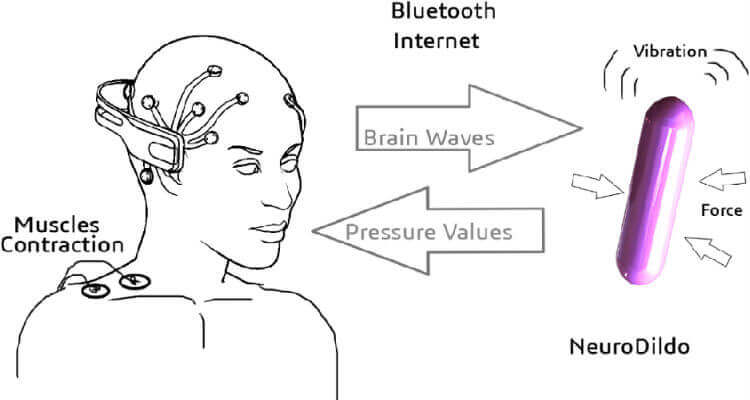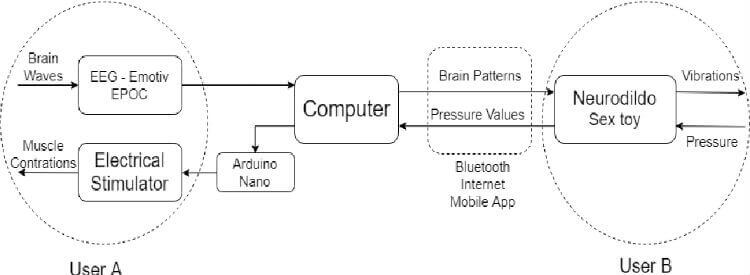Mind-Controlled Vibrator Could Make Sex Tech More Inclusive for People with Disabilities
How far off are we from being able to get off with just our brains?

Earlier this year, Future of Sex highlighted several advancements in the field of teledildonics at the 4th International Conference on Love and Sex with Robots.
Researcher Leonardo M. Gomes from the University of São Paulo presented the Neurodildo, a sex toy prototype that’s remotely controlled by the user’s brain waves.
With multiple future applications, the Neurdildo could enhance long-distance relationships or be used in tandem with sex robots or virtual sex workers. But the project’s primary goal has been to create an accessible device for people whose physical disabilities might limit them from independently operating commercial sex toys.
So how exactly does the Neurodildo work? And besides the whole mind control element a la Professor X, what sets it apart from the plethora of other remote sex toys that are already on the market?
Accessible sex tech

While the pleasure industry is beginning to produce more inclusive toys, traditional vibrators are often designed without accessibility in mind. So for people with limited strength or dexterity, standard features like power buttons might be a challenge to push, or toys without extended handles put the functionality of the product literally out of reach for users with a decreased range of motion.
Because of this, Gomes’ team adopted a user-centered design approach when developing the Neurodildo, focusing primarily on the needs of people with spinal cord injuries. Key factors included in their research were effectiveness, affordability, operability, and dependability.
They looked to existing accessible sex tech designed for disabled users, mainly hands-free toys like Eva by Dame, the Pulse Solo Essential by Hot Octopuss, or the Humpus, a wearable sex machine that’s secured in place on the user’s body by a belt.
Gomes’ research also referenced Bluetooth-controlled wearable vibrators that are currently available like Lush 2 by Lovense or the Club Vibe 3.Oh Panty Vibe by Ohmibod. While these toys are designed for couples, only one partner receives vibrations while the other is in control of the experience.
With the Neurodildo, both partners interact with each other and receive sensations through the device’s three main components:
The first is a vibrator that communicates with a computer or smartphone via Bluetooth and can produce eight different vibration patterns and levels of intensity. It also includes two sensors under a silicone sleeve that respond to external pressure.
The other two parts to the system are a brain-computer interface headset (BCI) and an E-stim device (Electrical Muscle Stimulation), which triggers muscle contractions in the user who’s operating the vibrator through mental commands. However, the process of controlling a vibrator with your mind is easier said than done.
Brain-computer interface technology

In the academic journal Robotics, Gomes breaks down the steps required to train the BCI software to detect unique brain wave patterns and “associate them with the user’s conscious intent to perform physical actions, like pushing or pulling an object and the neutral state of mind.”
Once the BCI has learned the user’s pre-trained patterns, the device can be used between two people either in person or online through a video chat. User A wears the BCI headset and E-stim electrodes on their body while User B holds the vibrator which is paired to a computer (or in future design iterations, a smartphone).
When user A concentrates on the pre-trained pattern, User B will feel the intensity of vibrations change depending on User A’s focus. A feedback loop of sensation is then created between the two users with the amount of pressure User B applies to the vibrator sending proportional levels of intensity back to the E-stim electrodes attached to User A’s body.
So how far off are we from, well, getting off with just our minds?

While the Neurodildo is full of potential, the technology is still in its infancy.
Currently, the device is still only operational via a computer, so the next phase is to create a mobile app that would wirelessly run the system.
Improving battery life and reducing the number of required electrodes is another crucial design revision, along with utilizing an open-source BCI headset to lower the overall cost for the end-user.
In the past, innovation within the field of teledildonics was hampered by broad patent restrictions, but since the 1998 patent on “interactive virtual control of sexual aids” expired last year there will be more opportunity to develop devices like the Neurodildo.
“An important contribution to the development of technology and of new products is the open-source hardware and software, which allow more developers to work on projects and use their knowledge to help other people,” Gomes writes.
Moving forward, Gomes’ team hopes to partner with local hospitals or rehabilitation centers to conduct clinical tests with users recovering from spinal cord injuries.
But in the meantime, they’re working to streamline the hardware and software setup while also refining the aesthetics of the vibrator itself, along with replacing the external sleeve with body-safe silicone before volunteers begin beta testing the device.
Even though the Neurodildo is built for disabled people, Gomes says it can be used by anyone regardless of physical ability.
Projects like this remind us that accessible design creates a better user experience for whoever is engaging with a product, whether it’s an everyday consumer item or a mind-controlled sex toy.
Image sources: Leonardo M. Gomes
Leave a reply
You must be logged in to post a comment.

















